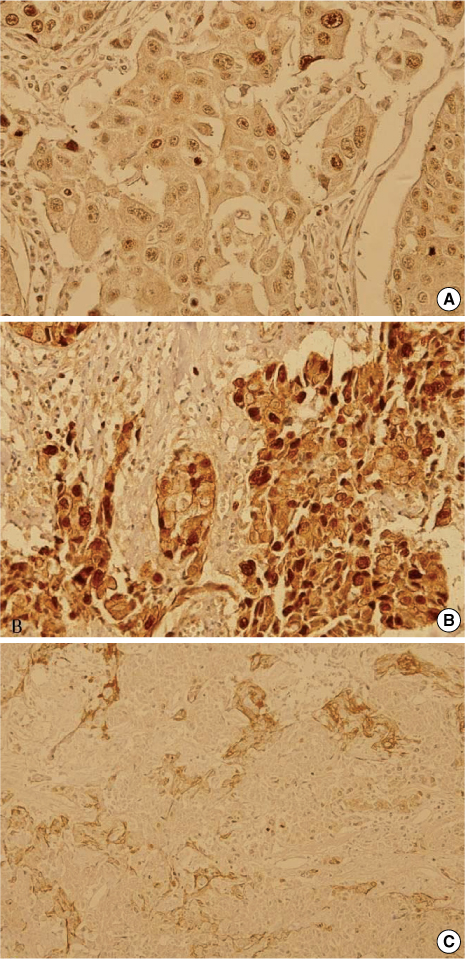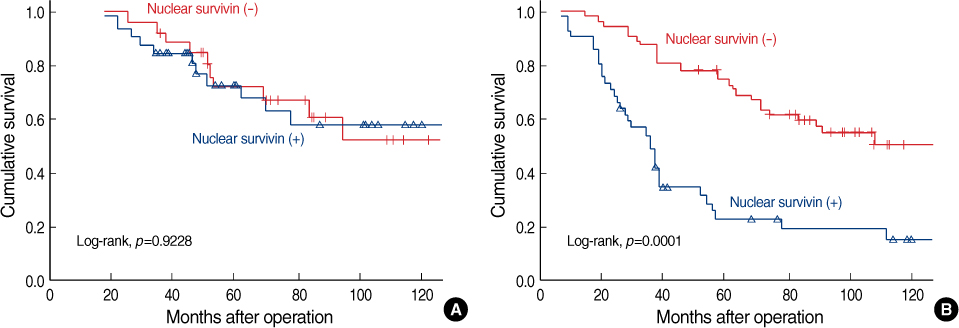J Breast Cancer.
2009 Dec;12(4):285-294. 10.4048/jbc.2009.12.4.285.
The Prognostic Significance of Survivin Expression in Breast Cancer
- Affiliations
-
- 1Department of Surgery, Yonsei University College of Medicine, Seoul, Korea. bwpark@yumc.yonsei.ac.kr
- 2Department of Pathology, Yonsei University College of Medicine, Seoul, Korea.
- 3Brain Korea 21 Project, Yonsei University College of Medicine, Seoul, Korea.
- 4Department of Surgery, Pochon CHA University College of Medicine, Seongnam, Korea.
- KMID: 2175523
- DOI: http://doi.org/10.4048/jbc.2009.12.4.285
Abstract
- PURPOSE
Survivin is a member of the inhibitors of apoptosis family. It has recently comes into the limelight as a promising tumor marker, but many previous reports have shown controversial results regarding the significance and prognostic value of a survivin expression. In this study we determined the correlation between the survivin expression and the conventional prognostic markers and we also investigated the outcomes according to the localization of the survivin expression. METHODS: Tissue microarray (TMA) blocks were made with formalin-fixed paraffin-embedded tissues from 185 breast cancer patients and the immunohistochemical staining was done using an anti-survivin antibody. Among these, 157 patients were available for a survivin expression. The conventional clinicopathologic features and overall survival were correlated with the localization of the survivin expression. RESULTS: Survivin was expressed in 101 breast cancers (64.3%). A higher cytoplasmic survivin expression were noted in the older group (p=0.003), in the node-negative cancers (p=0.012), in the earlier tumor stages (p=0.012) and in the cancers that had not been treated with adjuvant chemotherapy (p=0.014). On the contrary, a higher nuclear survivin expression was inversely correlated with an estrogen expression (p=0.006) and a progesterone receptor (p=0.043) expression. In terms of survival, a cytoplasmic expression was associated with improved overall survival (p=0.01) but a nuclear survivin expression was correlated with unfavorable overall survival (p=0.002). A high cytoplasmic to nuclear ratio of survivin was associated with improved overall survival (p=0.001) conversely, increased nuclear to cytoplasmic survivin ratio was correlated with unfavorable overall survival (p<0.0001). Multivariate analysis revealed that nuclear survivin expression (p=0.001) and high nuclear to cytoplasmic survivin ratio (p=0.012) were independent predictor of overall survival. CONCLUSION: Survivin is frequently expressed in primary breast cancer. A cytoplasmic survivin expression is a good prognostic predictor for patients with axillary node negative early breast cancers and a nuclear survivin expression is a worse independent predictor of overall survival for patients with axillary node positive breast cancers.
Keyword
MeSH Terms
Figure
Reference
-
1. Jiang X, Wilford C, Duensing S, Munger K, Jones G, Jones D. Participation of survivin in mitotic and apoptotic activities of normal and tumor-derived cells. J Cell Biochem. 2001; 83:342–354.
Article2. Li F, Ambrosini G, Chu EY, Plescia J, Tognin S, Marchisio PC, et al. Control of apoptosis and mitotic spindle checkpoint by survivin. Nature. 1998; 396:580–584.
Article3. LaCasse EC, Baird S, Korneluk RG, MacKenzie AE. The inhibitors of apoptosis (IAPs) and their emerging role in cancer. Oncogene. 1998; 17:3247–3259.
Article4. Altieri DC. Validating survivin as a cancer therapeutic target. Nat Rev Cancer. 2003; 3:46–54.
Article5. Ambrosini G, Adida C, Altieri DC. A novel anti-apoptosis gene, survivin, expressed in cancer and lymphoma. Nat Med. 1997; 3:917–921.
Article6. Kawasaki H, Altieri D, Lu CD, Toyoda M, Tenjo T, Tanigawa N. Inhibition of apoptosis by survivin predict shorter survival rates in colorectal cancer. Cancer Res. 1998; 58:5071–5074.7. Ikeguchi M, Kaibara N. Survivin messenger RNA expression is a good prognostic biomarker for oesophageal carcinoma. Br J Cancer. 2002; 87:883–887.
Article8. Wall NR, O\'Connor DS, Plescia J, Pommier Y, Altieri DC. Suppression of survivin phosphorylation on Thr34 by flavopiridol enhances tumor cell apoptosis. Cancer Res. 2003; 63:230–235.9. Zaffaroni N, Pennati M, Colella G, Perego P, Supino R, Gatti L, et al. Expression of the anti-apoptotic gene survivin correlates with taxol resistance in human ovarian cancer. Cell Mol Life Sci. 2002; 59:1406–1412.
Article10. Zhang W, Chen X, Qiu F. An antisense plasmid targeting survivin expression induces apoptosis and sensitizes hepatocarcinoma cells to chemotherapy. J Huazhong Univ Sci Technolog Med Sci. 2003; 23:387–391.11. Cao C, Mu Y, Hallahan DE, Bo Lu. XIAP and survivin as therapeutic targets for radiation sensitization in preclinical models of lung cancer. Oncogene. 2004; 23:7047–7052.
Article12. Kayaselcuk F, Nursal TZ, Polat A, Noyan T, Yildirim S, Tarim A, et al. Expression of survivin, bcl-2, P53 and bax in breast carcinoma and ductal intraepithelial neoplasia (DIN 1a). J Exp Clin Cancer Res. 2004; 23:105–112.13. Kennedy SM, O\'Driscoll L, Purcell R, Fitz-Simons N, McDermott EW, Hill AD, et al. Prognostic importance of survivin in breast cancer. Br J Cancer. 2003; 88:1077–1083.
Article14. Ryan BM, Konecny GE, Kahlert S, Wang HJ, Untch M, Meng G, et al. Survivin expression in breast cancer predicts clinical outcome and is associated with HER2, VEGF, urokinase plasminogen activator and PAI-1. Ann Oncol. 2006; 17:597–604.
Article15. Altieri DC. Validating survivin as a cancer therapeutic target. Nat Rev Cancer. 2003; 3:46–54.
Article16. Bao R, Connolly DC, Murphy M, Green J, Weinstein JK, Pisarcik DA, et al. Activation of cancer-specific gene expression by the survivin promoter. J Natl Cancer Inst. 2002; 94:522–528.
Article17. Span PN, Sweep FC, Weigerinck ET, Tjan-Heijnen VC, Manders P, Beex LV, et al. Survivin is an independent prognostic marker for risk stratification of breast cancer patients. Clin Chem. 2004; 50:1986–1993.
Article18. Asanuma H, Torigoe T, Kamiguchi K, Hirohashi Y, Ohmura T, Hirata K, et al. Survivin expression is regulated by coexpression of human epidermal growth factor receptor 2 and epidermal growth factor receptor via phosphatidylinositol 3-kinase/AKT signalling pathway in breast cancer cells. Cancer Res. 2005; 65:11018–11025.19. Tsuji N, Furuse K, Asanuma K, Furuya M, Kondoh K, Kamagata C, et al. Mutations of the p53 gene and loss of heterozygosity at chromosome 17p13. 1 are associated with increased surviving expression in breast cancer. Breast Cancer Res Treat. 2004; 87:23–31.20. Tanaka K, Iwamoto S, Gon G, Nohara T, Iwamoto M, Tanigawa N. Expression of survivin and its relationship to loss of apoptosis in breast carcinomas. Clin Cancer Res. 2000; 6:127–134.21. Chu JS, Shew JY, Huang CS. Immunohistochemical analysis of survivin expression in primary breast cancers. J Formos Med Assoc. 2004; 103:925–931.22. O\'Driscoll L, Linehan R, M Kennedy S, Cronin D, Purcell R, Glynn S, et al. Lack of prognostic significance of survivin, survivin-deltaEx3, survivin-2B, galectin-3, bag-1, bax-alpha and MRP-1 mRNAs in breast cancer. Cancer Lett. 2003; 201:225–236.23. Hinnis AR, Luckett JC, Walker RA. Survivin is an independent predictor of short-term survival in poor prognostic breast cancer patients. Br J Cancer. 2007; 96:639–645.
Article24. Okada E, Murai Y, Matsui K, Isizawa S, Cheng C, Masuda M, et al. Survivin expression in tumor cell nuclei is predictive of a favorable prognosis in gastric cancer patients. Cancer Lett. 2001; 163:109–116.
Article25. Grabowski P, Kühnel T, Mühr-Wilkenshoff F, Heine B, Stein H, Höpfner M, et al. Prognostic value of nuclear survivin expression in oesophageal squamous cell carcinoma. Br J Cancer. 2003; 88:115–119.
Article26. Lu B, Gonzalez A, Massion PP, Shyr Y, Shaktour B, Carbone DP, et al. Nuclear survivin as a biomarker for non-small-cell lung cancer. Br J Cancer. 2004; 91:537–540.
Article27. Li F, Yang J, Ramnath N, Javle MM, Tan D. Nuclear or cytoplasmic expression of survivin: what is the significance? Int J Cancer. 2005; 114:509–512.
Article28. Brennan DJ, Rexhepaj E, O\'Brien SL, McSherry E, O\'Connor DP, Fagan A, et al. Altered cytoplasmic-to-nuclear ratio of survivin is a prognostic indicator in breast cancer. Clin Cancer Res. 2008; 14:2681–2689.
Article29. Fortugno P, Wall NR, Giodini A, O\'Connor DS, Plescia J, Padgett KM, et al. Survivin exists in immunochemically distinct subcellular pools and is involved in spindle microtubule function. J Cell Sci. 2001; 115:575–585.
Article30. Mahotka C, Wenzel M, Springer E, Gabbert HE, Gerharz CD. Survivin-deltaEx3 and survivin-2B: two novel splice variants of the apoptosis inhibitor survivin with different antiapoptotic properties. Cancer Res. 1999; 59:6097–6102.31. Badran A, Yoshida A, Ishikawa K, Goi T, Yamaguchi A, Ueda T, et al. Identification of a novel splice variant of the human anti-apoptosis gene survivin. Biochem Biophys Res Commun. 2004; 314:902–907.
- Full Text Links
- Actions
-
Cited
- CITED
-
- Close
- Share
- Similar articles
-
- Expression of Survivin in Patients with Breast Cancer
- Prognostic Significance of KAI-1 and Survivin Expressions in Ovarian Epithelial Carcinomas
- A Novel Antiapoptosis Inhibitor, Survivin is Expressed in Uterine Cervical Cancer: The Relationship with prognostic Factors
- Expression of Survivin According to Malignant Progression of Breast Lesions
- Expression of Survivin Correlated with Antiapoptosis in Benign Prostate Hyperplasia and Prostate Cancer








